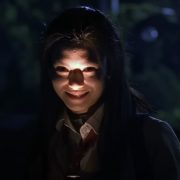On Monday, October 13th, Latin Horror was invited to the “Iconic Events & Lionsgate Presents Battle Royale 25th Anniversary 4K” screening in New York City.

It was exciting to arrive at the famous AMC Empire 25 Theatres on 42nd Street, in the heart of New York City. The Empire Theatre has been open since 1912—originally named the Eltinge Theatre. In 1998, the entire building was moved 168 feet to its current location, and in 2000, it reopened as the AMC Empire 25. The facade still features terracotta ornamentation and a Roman triumphal arch, while the interior has been restored with ancient Egyptian and Greek design details. It’s not only a cool theater to admire, but also a great place to see Battle Royale in 4K.
As I stated in a previous article (read here), this screening marked my first time seeing Battle Royale on the big screen. I already own all the previous DVD, Blu-ray, and even bootleg releases of this Japanese classic.

The Iconic Events presentation began with a short interview titled Kinji Fukasaku: A Master at Work, featuring Kenta Fukasaku, co-screenwriter of Battle Royale and son of director Kinji Fukasaku. The video offers an intimate look at the making of the film, presenting Kinji’s perspective through his son’s eyes. The interview covers his father’s history and unique directing approach, revealing how Kinji’s experience in a Japanese munitions factory during World War II influenced Kenta’s screenplay, how the 1970s protest movements inspired the film’s on-screen violence, and how a youth crime wave in Japan at the time helped shape the film’s concept and characters.

One new tidbit I learned was that Kenta had left the 1999 Battle Royale novel by Koushun Takami on the kitchen table while Kinji was deciding on his next film. What caught his father’s eye was a line from the book: “42 students. Only 1 survives.” That single line resonated deeply with Kinji and motivated him to collaborate with his son, making the film a very personal project rooted in his own experiences. Kinji Fukasaku: A Master at Work was an excellent introduction to the film—but a word of caution: it contains spoilers for newcomers.

The feature presentation of Battle Royale in 4K looked fantastic. There was one blurry shot and a couple of what seemed to be digital freeze frames, but I’d need to do a full comparison with the UHD 4K release by Arrow Films UK from 2022 to be sure. It could also have been an issue with the screening master. Aside from that, the colors, black levels, and skin tones were spot on, preserving the soft quality of the original 35mm film. The iconic red blood still pops vividly on screen.
Watching Battle Royale again, it still holds up with its shocking and provocative concept: teens versus adults. The “Millennium Educational Reform Act” is an extreme and far-fetched narrative device, but it creatively explores how society might deal with youth delinquency or a cultural shift in Japanese society. It’s important to remember that the film is infused with Kinji Fukasaku’s personal experiences.
As a teen, Kinji was forced to work in a munitions factory, part of a “Program” similar to the Millennium Educational Reform Act. This mirrors the film’s setting, which features a compound with military structures and methods similar to those on the fictional island of Okishima. He also “witnessed his own classmates being killed by artillery fire from U.S. Navy ships and was forced to hide under the bodies” of the deceased to survive. These experiences are reflected throughout the film, as students kill each other and hide from one another. Kinji also stated that the film was influenced by the protest movements of the 1970s, which is evident in characters like Shinji Mimura (Takashi Tsukamoto), Keita Iijima (Ren Matsuzawa), and others who team up to hack the government’s system on the island.
In addition, Japan in the 1990s was going through the so-called “Lost Generation”—a time when the economic bubble burst, jobs were scarce, crime was on the rise, and social standards were in decline. One example of this is seen when Shuya Nanahara (Tatsuya Fujiwara) discovers his father has committed suicide, unable to find employment. This moment sets the tone for one of the film’s central themes: the feeling of betrayal and abandonment. Kinji once said that after witnessing the deaths of his classmates and realizing he had been lied to by the Japanese government, “he developed a burning hatred of adults.”

Beyond all the action, spraying blood, and teenage crushes, Battle Royale offers deep commentary on society—and I love it for that too. I highly recommend it to everyone; it’s a personal favorite. So remember to RUN.
SYNOPSIS: Battle Royale is an intense and brutal story about Japanese high school students who are sent off by their government with three days to kill each other — until only one remains. With its blend of social commentary and high-stakes action, Battle Royale continues to influence modern dystopian storytelling and has inspired countless television shows, video games, and films.












Comments